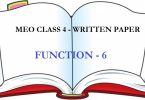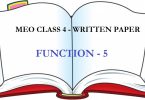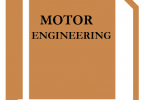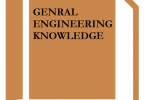SECTION – 3
TAKEN FROM NET
- Stability is determined principally by the relationship of the center of gravity and the
- aft perpendicular
- center of buoyancy
- keel
- center of flotation
ANS.: B
- At all angles of inclination, the true measure of a vessel’s stability is the
- metacentric height
- displacement
- righting moment
- inclining moment
ANS.: C
- The weight of the liquid displaced by a vessel floating in sea water is equal to the
- weight required to sink the vessel
- total weight of the vessel
- displaced submerged volume
- reserve buoyancy
ANS.: B
- When the height of the metacenter is less then the height of the center of gravity, a vessel has what type of stability?
- stable
- neutral
- unstable
- positive
ANS.: C
- Flooding of any compartment in a ship, resulting in a serious loss of reserve buoyancy, will always
- increase ship stability
- reduce ship stability
- cause a serious permanent list
- decrease the heeling moment
ANS.: B
- The stability of a vessel is normally the greatest when all fuel and water tanks are full because the
- center of gravity is lowered
- center of buoyancy is lowered
- reserve buoyancy is unchanged
- hull freeboard is increased
ANS.: A
- A vessel’s center of gravity is lowered when the
- freeboard is increased
- tanks are ballasted
- reserve buoyancy increase
- trim is increased
ANS.: B
- In the event of a collision, watertight integrity may be lost if
- the sounding tube cap from a damaged tank is missing
- the dogs on a manhole cover are secure
- you have recently replaced a gasket in a watertight door
- you operate the dewatering system from a flooded compartment
ANS.: A
- When the height of metacenter is greater than the height of the center of gravity, a vessel has what type of stability?
- positive
- neutral
- unstable
- negative
ANS.: A
- What is the usual effect of moving weight from low in the vessel to above the main deck?
- the stability is increased
- the draft is increased
- the stability is decreased
- the reserve buoyancy is decreased
ANS.: C
- If the result of loading a ship is an increase in the height of gravity, there will always be an increase in the
- metacentric height
- righting arm
- righting moment
- vertical moments
ANS.: D
- If a vessel looses its reserve buoyancy, it will
- float upright with the main deck awash
- capsize and float on its side
- remain unaffected if the hull remains intact
- most likely sink
ANS.: D
- The purpose of the inclining experiment on a ship is to determine
- lightweight and lightweight center of gravity location
- the position of the center of buoyancy
- the position of the metacenter
- the maximum load line
ANS.: A
- The reserve buoyancy of a vessel varies directly with changes in the vessel’s
- free surface
- freeboard
- rolling period
- none of the above
ANS.: B
- The reserve buoyancy of a ship consists of
- the void portion of the ship below the waterline which is enclosed and watertight
- all cofferdams, double bottoms, and wing tanks that are slack
- the part of the enclosed and watertight portion of a vessel above thewaterline
- the percentage of the volume of a compartment which can be occupied by water if flooded
ANS.: C
- Reducing the free surfaces within a vessel, reduces the
- natural roll period
- metacentric height
- waterplane area
- uncorrected height of the center of gravity
ANS.: A
- The free surface effects of a partially filled liquid tank decrease with increased
- density of the liquid
- placement of the tank above the keel
- displacement volume of the ship
- size of the surface area in the tank
ANS.: C
18. The distance between the bottom of the hull and the waterline is called
- tonnage
- reserve buoyancy
- draft
- freeboard
ANS.: C
- After transferring a weight forward on a vessel, the draft at the center of flotation will
- change, depending on the location of the center of gravity
- increase
- decrease
- remain the constant
ANS.: D
- Fuel oil tank vents are fitted with corrosion resistant screens to prevent
- flames entering through the tank vent
- escape of flammable vapors
- corrosion in the tank vent
- damage to the ball check
ANS.: A
- Reserve buoyancy is the
- unoccupied space below the waterline
- volume of intact space above the waterline
- excess of the buoyant force over gravitational force
- difference between buoyancy in salt and fresh water
ANS.: B
- With no environmental forces present, the center of gravity of an inclined vessel is vertically aligned with the
- longitudinal centerline
- center of flotation
- original vertical centerline
- center of buoyancy
ANS.: C
- The addition of weight at the longitudinal center of flotation will
- increase the forward draft and decrease the after draft
- decrease the forward draft and increase the after draft
- have no effect on the trim
- have no effect on the stability
ANS.: C
- In ship construction, beams are transverse girders which provide support to
- bulkheads
- deckhouse structures
- decks
- vertical frames
ANS.: C
- In ship construction, beam brackets are triangular plates joining the deck beam to a
- bulkhead
- frame
- stanchion
- deck longitudinal
ANS.: B
- Stanchions prevent the entire deck load on a ship from being carried by the
- bulkheads
- stringers
- frames and beam brackets
- deck longitudinals
ANS.: C
- Support of ship side plating is provided primarily by transverse
- beams
- girders
- frames
- bulkheads
ANS.: C
- Lighter longitudinal stiffening frames on the ship side plating are called
- stringers
- side frames
- side stiffeners
- intercostals
ANS.: A
- The heavier outboard strake of deck plating on a ship is called the deck
- stiffener
- beam
- stringer
- doubler
ANS.: C
- Where is thicker plating usually found in the construction of integral tanks on a ship?
- on the outside of the tank
- at the bottom of the tank
- at the top of the tank
- at the center of the tank
ANS.: B







An excellent initiative. Keep it updated with technology and regulations.